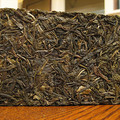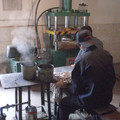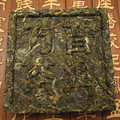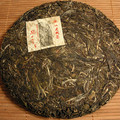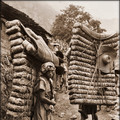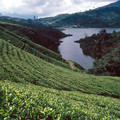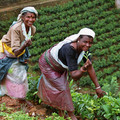Pu-erh tea
„The process used to convert máochá into ripened pu'er is a recent invention that manipulates conditions to approximate the result of the aging process by prolonged bacterial and fungal fermentation in a warm humid environment under controlled conditions, a technique called Wò Dūi (渥堆, "wet piling" in English), which involves piling, dampening, and turning the tea leaves in a manner much akin to composting.“
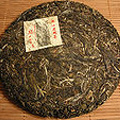
Quotes Tags: Pu-erh, Shu - Ripe Puerh
- Discussion: 0 comments
- Write a comment
Teas - Pu-erh
Lao Banzhang 2004 Bamboo Tube
 1 review
1 reviewLao Banzhang 2004 is a pu-erh pressed into bamboo tubes. Mighty and rich tea soup...
2005 (2015) Chawangpu Bulang Shan Old
 0 reviews
0 reviewsThis tea was found in friend´s warehouse in Menghai where was stored since 2005. Clean...
2012 Xiaguan JiaJi Tuocha In Box 100g
 0 reviews
0 reviewsConventional Xiaguan green box and classic "Jia Ji" recipe! This tuocha is pressed in...
2006 Langhe TF Meng Hai Chitse Beeng Cha
 1 review
1 reviewThis is one of classic recipe from Langhe tea factory which is similar with 8542 from...
2011 Mengmao Lao Shu Ye Sheng Xiao Bing
 1 review
1 review2011 Spring harvest. This material come from Baoshan area, 2600 meters high mountain...
2009 Cha Shu Wang "Jing Mai Chun Liao
 0 reviews
0 reviewsThis Pu-erh is called "Jing Mai Chun Liao Cha" (景迈纯料茶) - Jing Mai Mountain Pure...
Quotes - Pu-erh
„Indistinct fragrance is, by nature, restrained, hidden and it is only by steeping the tea and then smelling a cup that has just been emptied of tea can one appreciate this fragrance. Alternatively, one can also smell the steeped leaves. “

Quotes Tags: Pu-erh, Experiencing tea
Video - Pu-erh
Theme
Teas
2003 CNNP Yi Wu Arbor Ming Chien „Hundred
 1 review
1 reviewProcessing: discontinuation of oxidation, rolling, sun drying, humidification, pressing performed...
2006 Myanmar Kokang Mei Hua Bing Raw Puerh
 1 review
1 reviewThis little cake come from border area with Myanmar from Kokang (果敢; pinyin: Guǒgǎn), area about 20km...
2013 Zhejiang Long Jing Hong Cha AAA Grade
 1 review
1 reviewMaterial came from the same tea trees with Longjing green tea. The dry tea leaves are rolled tightly and...
Tea by region
We will help you with tea selection.
Do you like quality loose tea?
We will help you to find the right one for you. Be inspired by tea ratings of other tea lovers. Rating stars could help you.


Review your cup of tea.
Review the tea you are drinking and help other tea lovers to find the right cup of tea.






 Shops
Shops Share on Facebook
Share on Facebook






